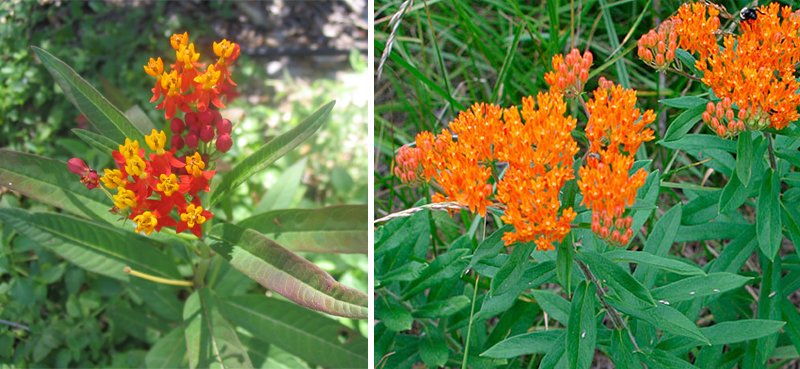Celebrate Western Monarchs
Dear Smart Yards Community,
February 5 is World Monarch Day and Smart Yards Co-op invites you to join us in celebrating the awe-inspiring journey of the Western monarch butterfly. In this edition of our newsletter, we delve into the fascinating world of monarch migration and want to also shed light on the critical role of milkweed, the required host plants for caterpillars of the monarch butterfly, particularly the debate surrounding tropical milkweed and its native counterparts.
The Milkweed Dilemma: Tropical vs. Native Varieties
Milkweed is not just a plant; it's a lifeline for monarch butterflies as well as many other pollinators. However, the introduction of tropical milkweed (Asclepias curassavica) has raised concerns among pollinator groups and scientists. Unlike most native milkweeds, tropical milkweed does not go dormant in the fall or winter, potentially disrupting the monarchs' natural migratory patterns.
Tropical milkweed (A. curassavica, left) can be difficult to distinguish from orange butterflyweed (A. tuberosa, right). Orange butterflyweed is also a low-growing milkweed with bright orange flowers that is native across much of North America. (Photo, Left: Justin Lebar / Wikimedia Creative Commons; Photo, Right: Joshua Mayer / Flickr Creative Commons)
The high concentration of cardenolides in tropical milkweed, while beneficial in combating a parasite called OE (Ophryocystis elektroscirrha), introduces a new set of challenges. Monarchs exposed to OE on tropical milkweed can become carriers, potentially spreading the disease to healthier butterflies during interactions. OE is spread by spores and can cause the adult monarch’s wings to become deformed. Additionally, the loss of Native milkweed plants in monarch’s spring and summer breeding areas across the United States is believed to be a significant factor contributing to the reduced number of monarchs recorded in overwintering sites in California and Mexico. Agricultural intensification, development of rural lands, and the use of mowing and herbicides have all reduced the abundance of milkweeds in the landscape.
A monarch butterfly infected with OE may not be able to eclose from its chrysalis, or may emerge with wings it cannot extend and flatten. (Photo: Dara Satterfield, Project Monarch Health)
Milkweed + More Plants for Monarchs
The foundations of any monarch butterfly garden undoubtedly rests on our native milkweeds (Asclepias spp.), as these are the only plants monarch caterpillars can eat. We at Smart Yards enjoy planting and nurturing these Milkweeds: Asclepias fascicularis (Narrowleaf milkweed) and Asclepias speciosa (Showy milkweed). Unlike their caterpillars, adult monarchs are generalist feeders, and they need varied nectar sources year round. Let us know if you’d like to get a Monarch Meadow that other pollinators and you will also enjoy.
At Smart Yards Co-op, we cherish Western Monarch Day for various reasons:
They are absolutely beautiful: Western monarchs, with their vibrant hues, are not just visually appealing but also crucial pollinators
Their mysterious migration deserves attention: The incredible journey of these butterflies prompts us to reflect on our impact on the environment and conservation efforts
A boost to conservation efforts: Recognizing this day raises awareness and support for conservation initiatives. It's a reminder of the urgency to protect these magnificent creatures.
As we continue to celebrate Western Monarch Day throughout the year let's continue our commitment to creating sustainable and monarch-friendly environments in our outdoor spaces. By choosing native milkweed and other native plants that support the Monarchs as well as native bees and other pollinators habitats, we can ensure a future where monarch butterflies continue to grace our landscapes.
“We delight in the beauty of the butterfly, but rarely admit the changes it has gone through to achieve that beauty.”






